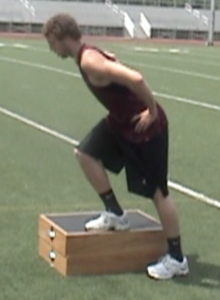by Mitch Hauschildt, MA, ATC, CSCS
The single leg exercise may look simple, but it is very dense and challenging exercise that can be used for healthy and injured people alike. It requires a lot of strength, stability, motor control, glute control, foot control and on and on. It is a great transition exercise from a warm up to more complex movement patterns and it can be progressed in a ton of ways. I use them as part of my rehab programs as well as within my strength and conditioning workouts.
Here are some basic coaching points:
- Keep both toes straight ahead. Allowing the toe to point out is virtually the same as allowing the knee to collapse into valgus.
- Keep the knee in line with the hip and 2nd toe. The knee MUST NOT be allowed to fall into a valgus position.
- Sit the weight back onto the heel of the stance leg.
- Lean forward with the upper body and reach back with the heel until it hits the floor. This will help to get the glutes engaged and in the game.
- Keep hips level and out of a Trendelenburg position.
- Use the highest box possible that allows the individual to control the entire movement.
- Place hands either in front of the body or on the waist.
Here are some variations of the single leg squat:
- RNT variation that pulls the knee into valgus to exaggerate the mistake and get the glutes engaged in the movement. It may seem counterintuitive to exaggerate the mistake, but it works very well to make corrections.
- A band around the waist that will also get the hip musculature engaged to improve stability and control in the frontal plane.
- Placing a load in front of the body to allow for a posterior weight shift and work around an ankle dorsiflexion restriction.
- Pressing a load overhead in the hand opposite the stance leg. This works great for training the back functional line to encourage shoulder and hip stability.
- Pressing a load overhead in the hand that is on the same side as the stance leg. This variation challenges the body’s stability and control in the frontal plane.
- Placing a band around the mid foot and pulling the foot into pronation. This is a bit of an RNT variation for those who tend to pronate more than we would like.
- Put a small band under the big toe and ask the individual to keep the band from slipping out. This will engage the big toe and teach them to use it in a single leg stance position.
Check out this video of me explaining many of these variations and coaching points.


Leave a Reply